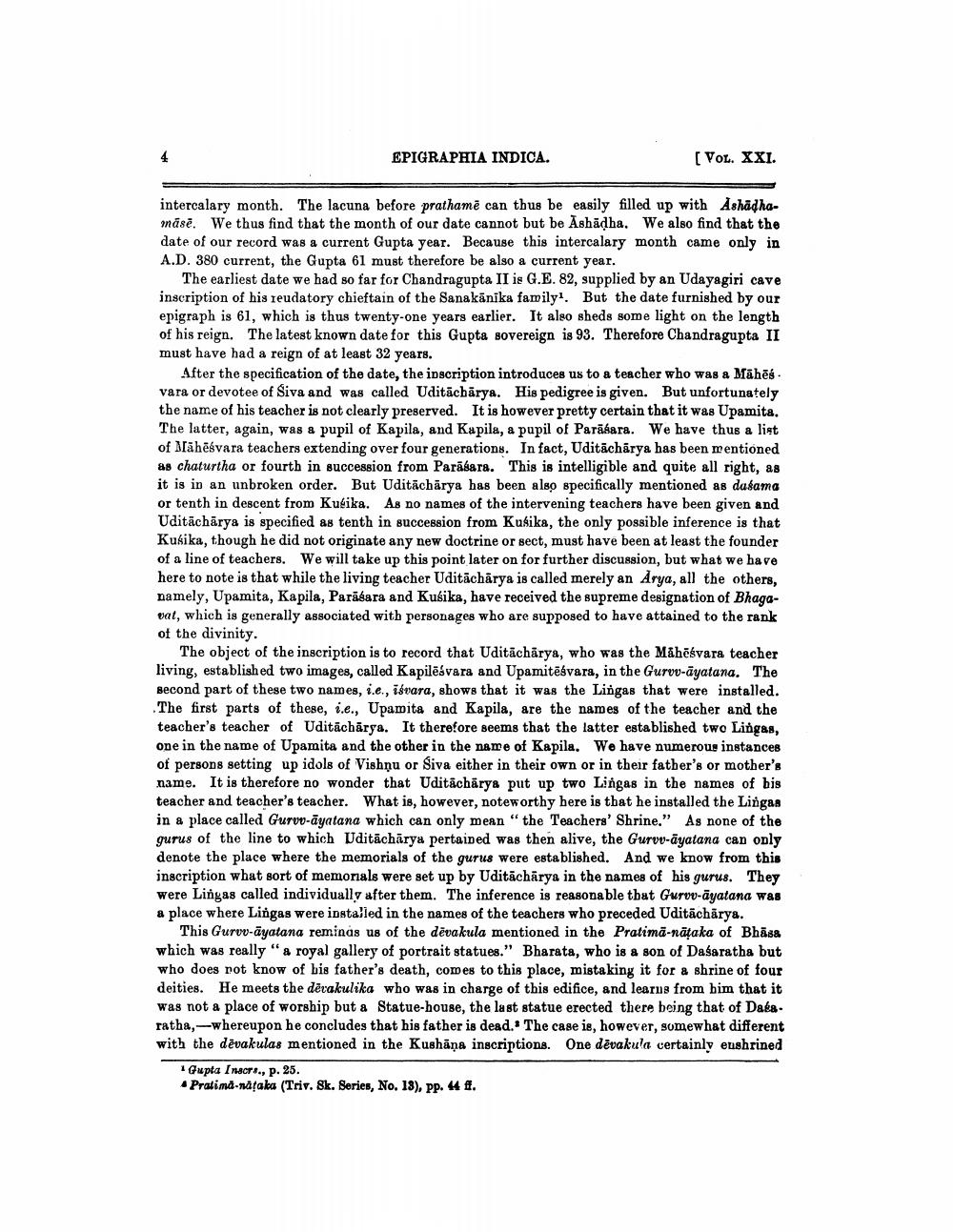________________
EPIGRAPHIA INDICA.
(VOL. XXI.
intercalary month. The lacuna before prathamē can thus be easily filled up with Ashādhamāsē. We thus find that the month of our date cannot but be Ashādha. We also find that the date of our record was a current Gupta year. Because this intercalary month came only in A.D. 380 current, the Gupta 61 must therefore be also a current year.
The earliest date we had so far for Chandragupta II is G.E. 82, supplied by an Udayagiri cave inscription of his reudatory chieftain of the Sanakānika family. But the date furnished by our epigraph is 61, which is thus twenty-one years earlier. It also sheds some light on the length of his reign. The latest known date for this Gupta sovereign is 93. Therefore Chandragupta II must have had a reign of at least 32 years.
After the specification of the date, the inscription introduces us to a teacher who was a Māhēs. vara or devotee of Siva and was called Uditācbārya. His pedigree is given. But unfortunately the name of his teacher is not clearly preserved. It is however pretty certain that it was Upamita. The latter, again, was & pupil of Kapila, and Kapila, a pupil of Parādara. We have thus a list of Māhēśvara teachers extending over four generations. In fact, Uditāchārya has been mentioned as chaturtha or fourth in succession from Parādara. This is intelligible and quite all right, as it is in an unbroken order. But Uditāchārya has been also specifically mentioned as datama or tenth in descent from Kubika. As no names of the intervening teachers have been given and Uditāchārya is specified as tenth in succession from Kusika, the only possible inference is that Kusika, though he did not originate any new doctrine or sect, must have been at least the founder of a line of teachers. We will take up this point later on for further discussion, but what we have here to note is that while the living teacher Uditācharya is called merely an Arya, all the others, namely, Upamita, Kapila, Parādara and Kusika, have received the supreme designation of Bhagavat, which is generally associated with personages who are supposed to have attained to the rank of the divinity.
The object of the inscription is to record that Uditācharya, who was the Mahēśvara teacher living, established two images, called Kapilēsvara and Upamitēsvara, in the Guruv-āyatana. The second part of these two names, i.e., isvara, shows that it was the Lingas that were installed. The first parts of these, i.e., Upamita and Kapila, are the names of the teacher and the teacher's teacher of Uditáchārga. It therefore seems that the latter established two Lingas, one in the name of Upamita and the other in the name of Kapila. We have numerous instances of persons setting up idols of Vishnu or Siva either in their own or in their father's or mother's name. It is therefore no wonder that Uditācharya put up two Lingas in the names of bis teacher and teacher's teacher. What is, however, noteworthy here is that he installed the Lingas in a place called Guruv-āyatana which can only mean "the Teachers' Shrine." As none of the gurus of the line to which Uditācharya pertained was then alive, the Guruv-āyatana can only denote the place where the memorials of the gurus were established. And we know from this inscription what sort of memorials were set up by Uditācharya in the names of his gurus. They were Lingas called individually after them. The inference is reasonable that Guruv-āyatana was a place where Lingas were installed in the names of the teachers who preceded Uditācharya.
This Gurvv-āyatana reminas us of the dēvakula mentioned in the Pratima-nāšaka of Bhāsa which was really " a royal gallery of portrait statues." Bharata, who is a son of Dasaratha but who does not know of bis father's death, comes to this place, mistaking it for a shrine of four deities. He meets the dēvakulika who was in charge of this edifice, and learn from him that it was not a place of worship but a Statue-house, the last statue erected there being that of Dala. ratha,-whereupon he concludes that his father is dead. The case is, however, somewhat different with the dëvakulas mentioned in the Kushāņa inscriptions. One dēvakula certainly enshrined
Gupta Inscts., p. 25. . Pratima-näpaka (Triv. Sk. Series, No. 13), pp. 44 f.




